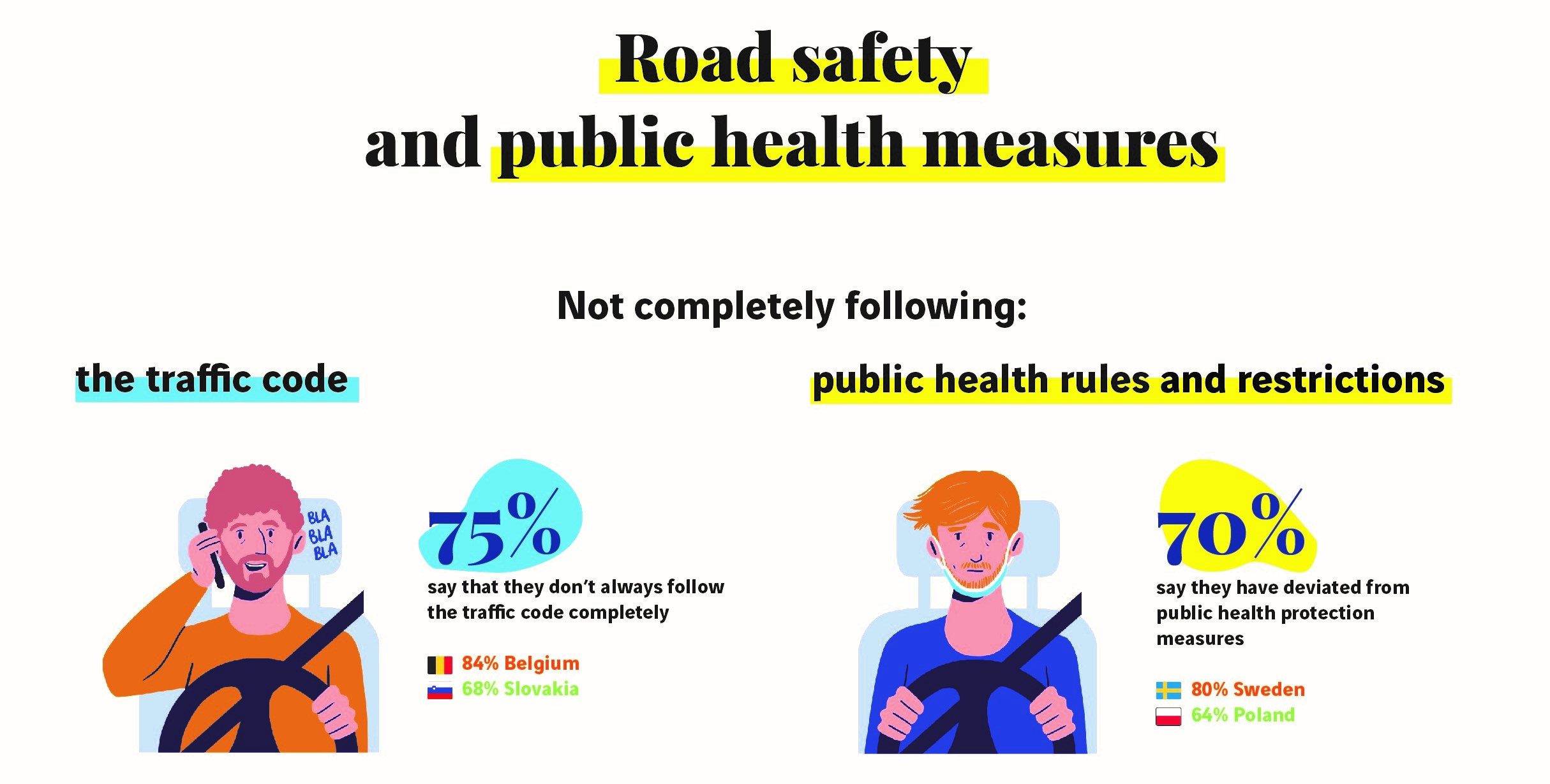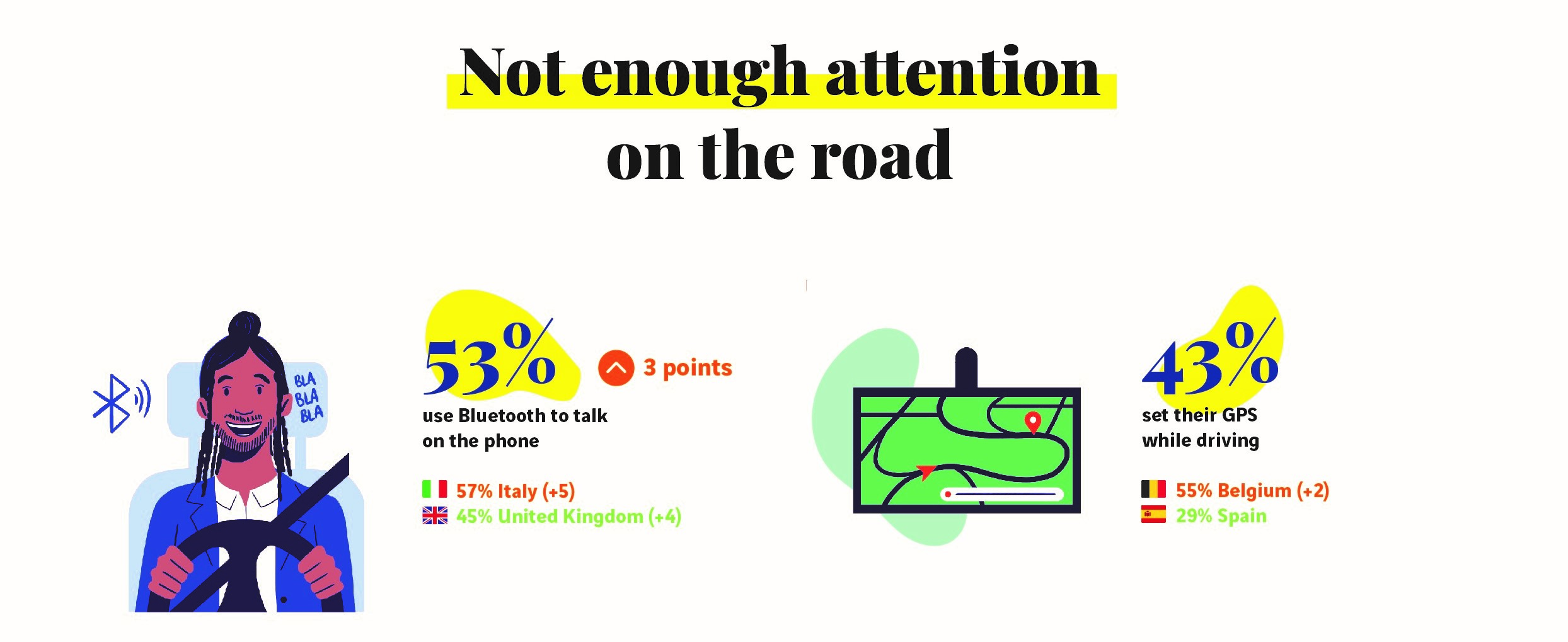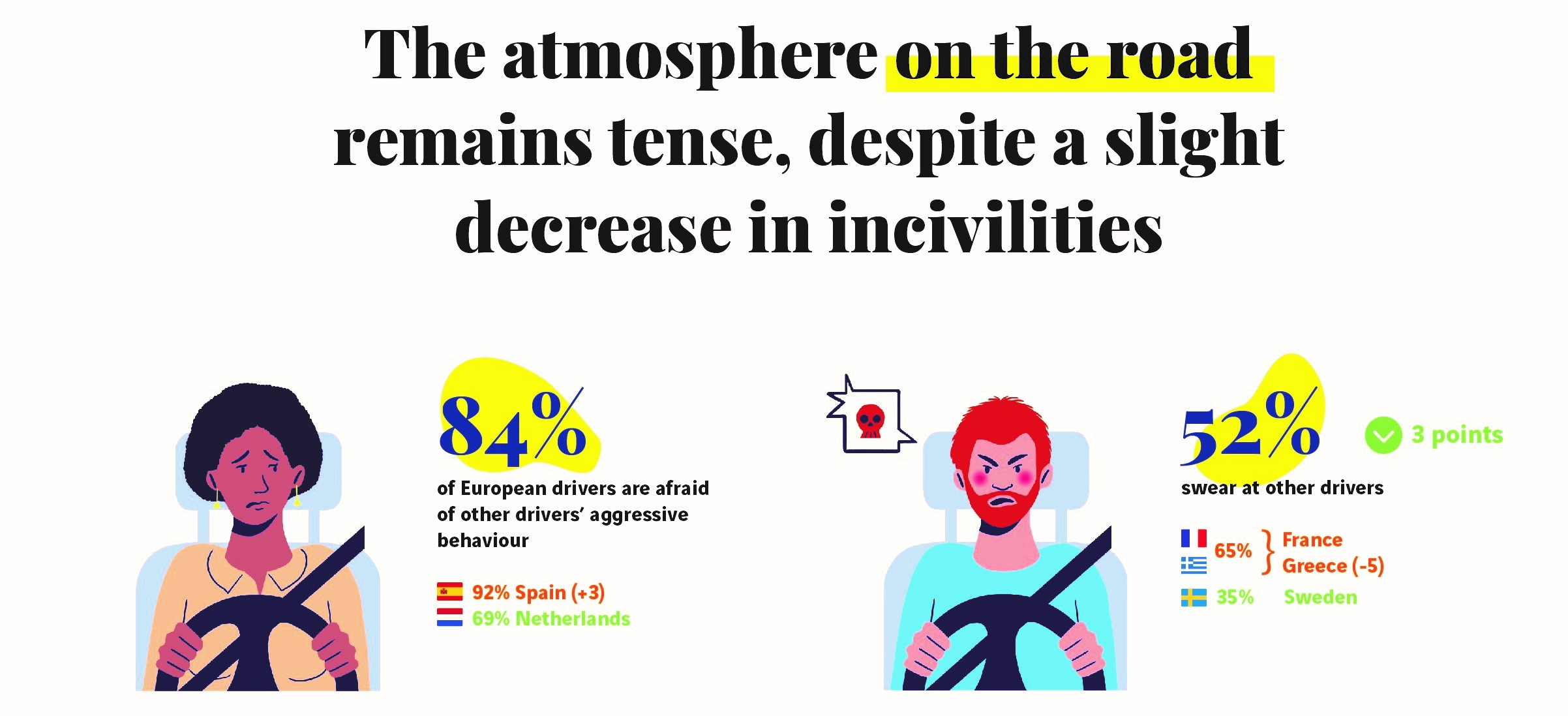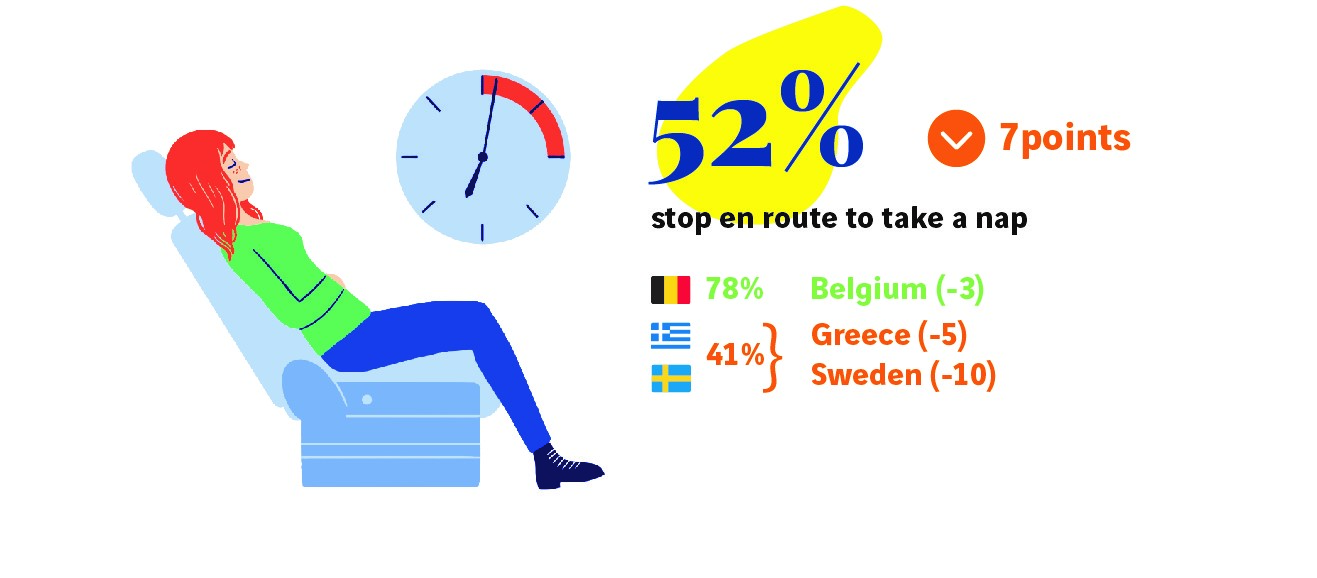77% of European drivers who take liberties with the traffic code do the same with public health guidelines
Conducted by Ipsos among 12,400 people in 11 European countries, this wide-ranging survey provides an overview of the behaviour and perceptions of Europeans behind the wheel. It makes it possible to monitor the evolution of risky behaviours and good practices in order to better target prevention campaigns in France and other European countries. In the midst of the ongoing pandemic, it also looked at how attitudes towards the traffic code correlated with attitudes towards public health measures.
Main findings
Traffic code and public health guidelines: bending the rules here and there is common

- More than 7 in 10 European drivers (75%) admit that they have violated the traffic code and 7 in 10 do not always follow public health regulations.
- 45% of Europeans follow health guidelines primarily out of a concern for others, compared to only 33% who follow the traffic code for the same reason.
⇒ 77% of European drivers who take liberties with the traffic code do the same with public health guidelines.
Inattentiveness: drivers continue to pay less attention the road

- 53% of European drivers talk on the phone while driving by using a Bluetooth system (+3 points over one year and +10 points over 5 years), even though this is still as distracting as other ways to talk on the phone1 .
- 43% set their GPS while driving (+4 points over 5 years).
⇒11% have had or nearly had an accident because they were using their phone while driving.
Incivilities: despite some behavioural changes, there is still plenty of tension on the road

- 12% of European drivers (-4 points over one year) admit that they become someone else behind the wheel.
- 52% (-3) say that they sometimes insult other drivers.
⇒ 84% have felt afraid of other drivers’ aggressive behaviour.
Drowsiness: risk-taking is still too widespread and some best practices are down

- 40% of European drivers (-5 points) don’t follow the recommended practice of taking a break every 2 hours, even though 73% of them are aware of it.
- 52% stop en route to take a nap.
⇒ 12% have had or nearly had an accident due to falling asleep at the wheel.
Motorway road worker safety: high levels of indifference may lead to serious consequences
- 51% of European drivers forget to slow down in work zones (-3).
Whether they are part of the traffic code or public health guidelines, rules are often seen more as constraints than as a form of protection. When drivers allow themselves to bend the rules a little, they are focusing on their immediate benefit and ignoring the potential risk of an accident, hoping that they are in enough control to avoid it. The vast majority of accidents, however, occur when people have not fully accounted for the risks of violating the traffic code.
Bernadette Moreau, General Delegate of the VINCI Autoroutes Foundation for responsible driving
1 Study of the effects of phone conversations on driver attention span and perception (2014), Centre d’Investigation Neurocognitives et Neurophysiologiques de l’Université de Strasbourg (Ci2N) for VINCI Autoroutes Foundation.
Detailed Results
Traffic code and public health guidelines: bending the rules here and there is common
When they don’t understand the reason for a rule, European drivers are more likely to break it...
75% of European drivers admit that they do not always follow the traffic code. Europeans also report taking certain liberties with public health measures, but to a lesser degree than with the traffic code: 70% (a difference of 5 points) say they don’t always follow health guidelines (preventative measures, lockdowns, curfews, etc.). Also, whereas 30% of Europeans said they always follow public health guidelines, only 25% said the same for the traffic code.
Most of the people who sometimes took liberties with the rules, whether they be public health guidelines or the traffic code, gave the same reason for doing so: they did not always think the rule made sense or that it fit a given situation (52% said so in relation to the traffic code, compared to 45% for public health guidelines). The impression that some rules are in place only to give tickets was much more common with regard to the traffic code (29% than it was for public health guidelines (15%). Conversely, some people think that if they are particularly vigilant, they can allow themselves to break the rules. This was more the case for health guidelines (42% of Europeans) than it was for road safety (22%).
People who say they follow the rules seem to be mostly motivated by the goals of these rules, namely avoiding the risk of having an accident or getting infected. In all cases, the fear of penalties was the least motivating factor. Thinking about others was a much more common justification for following health guidelines (mentioned by 45%) than it was for road safety (33%), especially when people were thinking about their friends and family (23% vs. 11% in Europe). While French people were the most concerned with their own safety on the road (33% vs. 28% for health guidelines), this motivation and preference were less prevalent in Europe and in the United Kingdom (26% for following the traffic code vs. 27% for following public health guidelines). Trust in the well-foundedness of the traffic code motivates 30% of European drivers vs. 17% for health guidelines. Fear of penalties was a weak motivator for rule-following (11% of European respondents for both the traffic code and health guidelines).
Because they are less aware of their own behaviour, fewer British people than the European average admit that they would probably be at least partly at fault in the case of an accident (34%) and to a lesser degree, they are also less likely to admit personal responsibility if they catch Covid-19 (40%).
...especially behind the wheel
A particularly high number of British drivers violate the traffic code:
- 88% of European drivers drive a few kph over the speed limit.
- 62% continue through the intersection when the light is yellow or has just turned red.
- 51% forget to use their turn signals when passing other vehicles or changing direction.
- 43% don’t come to a complete stop at a stop sign.
- 28% double park.
- 8% say they drive when over the legal alcohol limit, if they’re not feeling drunk.
- 7% say they get behind the wheel after taking medication that might affect their awareness.
- 3% get on the road after smoking marijuana or taking drugs.
Inattentiveness: drivers continue to pay less attention the road
Despite a slight decrease, drivers remain keenly aware of the dangers of inattentiveness: 54% of European drivers identify it as one of the main causes of deadly accidents on the roads in general, compared to 40% for motorways in particular. Also, 11% of European drivers have already had, or almost had, an accident due to someone using their phone while driving.
However, more and more drivers are adopting dangerous behaviours around distractions:
- 76% of European drivers (-2) admit that they take their eyes off of the road for more than 2 seconds
- 53% (+3 points over one year and +10 over five years) say they talk on the phone while driving, using a Bluetooth system to connect to their car’s built-in speakers. This practice is just as dangerous in terms of distraction as other kinds of phone use.
- 43% (+4 points over 5 years) set their GPS while they are driving.
- 22% send and/or read text messages or e-mails while driving.
- 21% (+2 over one year and +5 over 10 years) use an app to notify other drivers of certain events while behind the wheel.
- 32% use an earpiece, headset, or headphones to talk on the phone while driving.
- 23% make calls holding the phone in their hands.
- 7% even watch films or videos on a smartphone or tablet while driving.
Incivilities: despite some behavioural changes, there is still plenty of tension on the road
During these difficult times, European and British drivers have become a little less critical of their fellow drivers on the road: they see them as less stressed (32%, -6 points) and aggressive (26%, -2), and more attentive behind the wheel (18%). Still, these other drivers have not become blameless in their eyes. 79% (-4) used at least one negative adjective to describe them, most often calling them irresponsible (46%) and dangerous (26%, -2). Their judgement of themselves remained unchanged, with 97% using at least one positive adjective to describe their own driving and only 12% (-2) admitting to at least one error.
Some drivers, however, are aware that getting in the car can have a negative influence on their behaviour. In fact, 12% of European drivers say that they are not really the same person when they get behind the wheel, becoming more nervous, impulsive, or aggressive than normal. For 18% of these drivers, the protection of being in their car makes them feel like they are “in a bubble” so they pay less attention to other people. 13% of them even feel that on the road, “it’s every man for himself”.
Aggressive behaviour and incivilities behind the wheel are slightly down compared to 2020, but they remain all too common: 52% (-3) of European drivers say that they have insulted other drivers in the past, 47% (-4, 36%, -9) have honked their horn impatiently, 30% (-3) have deliberately tailgated a driver who’s annoying them, 30% (-4) have passed on the right on the motorway.
This change should be put into context, however, since 20% of European drivers don’t hesitate to get out of their car and explain themselves, while the number of drivers who say they have been afraid of the aggressive behaviour of another driver has remained at a high level (84%).
British drivers do, however, appreciate small gestures of politeness. This means that when they are in the car and another driver lets them go ahead with a polite gesture, this leads them to report their average level of well-being as 8.2/10. Also, when they let another car go ahead and the driver makes a gesture to thank them, they report their average level of well-being as 8.3/10. Finally, when someone apologizes for making an error while driving by making a hand gesture, they report their level of well-being as 7.8/10.
Drowsiness: risk-taking is still too widespread and some best practices are down
French people are more aware of the risk of drowsy driving on the motorway, listing drowsiness as their number 2 risk (38%, just after excessive speed, 39%) for the first time since 2014. Europeans in general placed drowsiness as the number 4 cause of deadly motorway accidents (20%). There were, however, many Europeans who reported that drowsiness had caused an accident or incident they had been involved in:
- 12% have had or nearly had an accident due to falling asleep at the wheel.
- 24% (-3) have dozed off for a few seconds while driving.
- 15% (-3) have drifted into the shoulder or emergency lane due to inattention or drowsiness.
24% (-4) of European drivers, however, believe that they can still drive when tired and 35% (-16) will do so, even if they feel very tired, because they have no other choice.
On long trips, some practices that can lead to drowsy driving are down, but they are still too common:
- 82% (-4) of European drivers go to bed later or get up earlier than usual before a long trip.
- 74% (-3) finish packing late at night before they leave.
- 62% (-5) leave at night.
At the same time, some good habits that are highly effective in preventing drowsiness are on the decline:
83% of drivers plan their departure time based on when they will be the least tired.
- 74% (-3) put delay departure when they are tired.
- 68% (-3) switch with another driver during the trip.
- 52% (-7) stop en route to take a nap - the most effective way to avoid the risk of falling asleep at the wheel.
The amount of time that people drive before they take a break also decreased slightly: 3:02 (-4min) for European drivers. As for the recommendation that drivers take a break every two hours, 40% (-5) of European drivers do not follow it, despite it being known to 73% of them. Among those who do not follow this recommendation, 47% say that they only stop when they feel very tired and 18% think that this recommendation is too strict and not adapted to their situation. 8% say that they don’t have enough time to take a break every two hours.
Survey methodology:
To conduct the Responsible Driving Barometer survey, from 9 to 22 March 2021, Ipsos conducted an online survey of 12,400 people aged 16 and over, including 2,400 French people and at least 1,000 people in each of the 10 other countries surveyed (Germany, Spain, France, United Kingdom, Greece, Italy, Netherlands, Slovakia, Sweden). The representativeness of each sample is ensured by the quota method.
About the VINCI Autoroutes Foundation for Responsible Driving
Founded in February 2011, the VINCI Autoroutes Foundation for Responsible Driving is a laboratory, observatory and source of information specifically dedicated to changing driver behaviour.
Primarily focused on improving road safety, it aims to promote responsible road behaviour and, in 2018, it expanded its sphere of action to include environmental and educational measures (“responsible behaviour”).
Its work includes:
- innovative scholarly research into certain areas of risky driver behaviour, into protecting the environment, and into the use of education and reading as a means to improve driver behaviour.
- carrying out information campaigns to raise awareness of road risks.
- funding initiatives by non-profit associations and citizen initiatives aimed at encouraging responsible driving.
http://fondation.vinci-autoroutes.com and Twitter account: @FondationVA, Facebook and Linkedin
http://roulons-autrement.com and Twitter account: @RoulonsA



